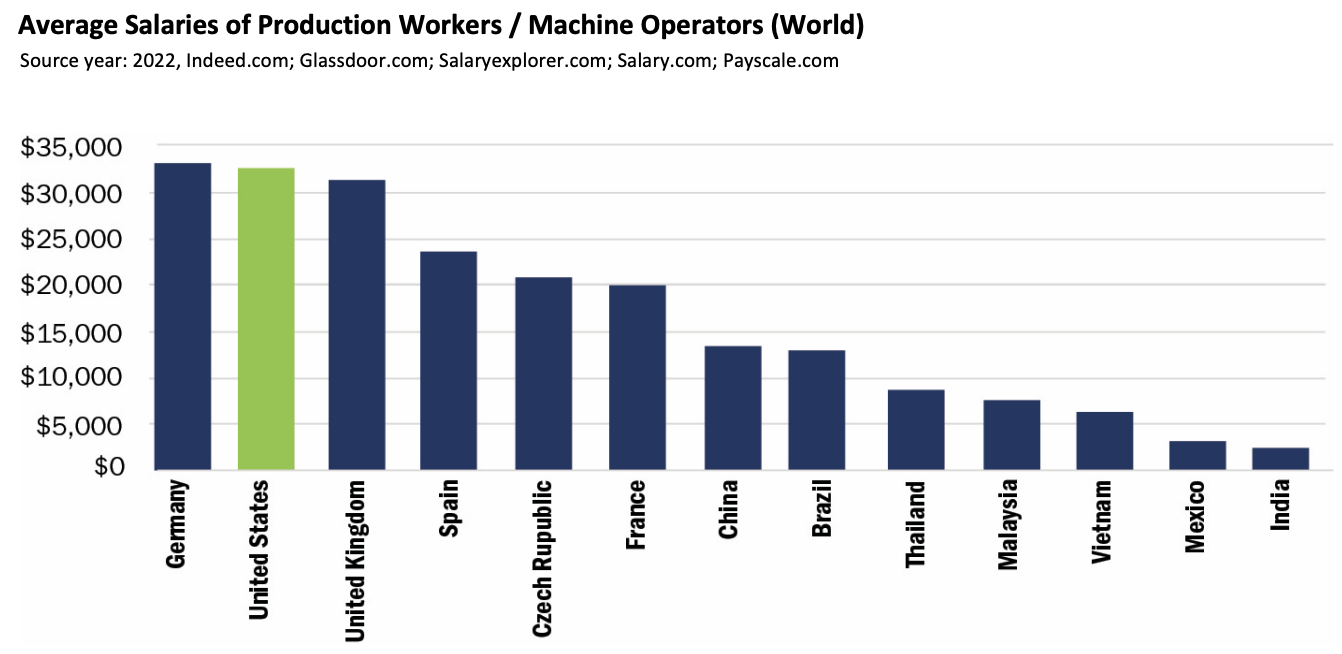When comparing manufacturing costs between Mexico and China, a myriad of factors play crucial roles in determining the total cost of producing items. Both countries offer unique advantages and challenges influenced by underlying energy and labor costs, material expenses, government subsidies, logistics, and tariffs. Labor costs often present the most direct comparison, with Mexico historically offering a competitive edge due to its proximity to the U.S. market, potentially lower logistics costs, and favorable tariffs under agreements like the USMCA.
Meanwhile, China's vast manufacturing infrastructure, government subsidies, and efficient supply chains have traditionally offset its higher shipping and logistical costs to global markets. Material costs in both countries are subject to global commodity prices and local availability, while energy costs can vary significantly due to national policies and resource availability. Additionally, the impact of tariffs and trade agreements cannot be understated, as they directly affect the final cost of goods and the attractiveness of each country as a manufacturing hub.
A comprehensive analysis of these factors is essential for businesses looking to optimize their manufacturing strategy and supply chain efficiency in the global market.
Mexico vs China Manufacturing: An Overview
Manufacturing in Mexico and China has been a topic of great interest for many companies seeking to optimize their production processes. Mexico and China are two prominent players in the global manufacturing market, each offering unique advantages and challenges. Companies looking to manufacture in Mexico vs. China must carefully consider factors like labor costs, trade agreements, tariffs, and intellectual property protections. Mexico boasts a strategic geographical location that provides easy access to the lucrative U.S. market. Additionally, Mexico's participation in the United States-Mexico-Canada Agreement (USMCA) has further enhanced its appeal to foreign companies looking to establish manufacturing operations in the region. On the other hand, China has long been known as the world's manufacturing hub due to its vast production capabilities and lower labor costs.
Cost of Manufacturing in Mexico
When considering the cost of manufacturing in Mexico, several key factors come into play. Labor costs in Mexico are typically lower compared to those in the United States, making it an attractive option for companies looking to reduce production expenses. Energy costs in Mexico are also relatively competitive, further enhancing the cost-effectiveness of manufacturing in the country. Material costs in Mexico can vary depending on the type of industry and proximity to suppliers.
Labor Costs
Hourly wages in Mexico are generally lower than in the U.S. and in China, which can result in significant cost savings for businesses looking to manufacture in the country. The availability of skilled labor at competitive rates makes Mexico an ideal destination for companies seeking to outsource manufacturing operations. If a product has a high amount of labor content, Mexico can typically be very competitive when comparing manufacturing costs to China.

Energy Costs
Energy costs in Mexico are typically lower compared to many other countries, contributing to the overall affordability of manufacturing in the region. The availability of diverse energy sources, including natural gas and renewable energy, further enhances the cost competitiveness of Mexico as a manufacturing location. Notably, Mexico's natural gas prices are significantly lower than those in China, tied closely to the U.S. market where recent discoveries have kept prices relatively low. In fact, natural gas in China can cost 50 to 170 percent more than in Mexico, and at times, prices are up to three times higher.
While energy pricing is not a direct cost for companies buying from Mexico, it does affect manufacturing costs. However, it's important to note that electricity prices in Mexico are generally higher than those in China and most cities in the United States. Since the deregulation of Mexico's electricity market in 2014, aimed at reducing these high costs by encouraging competition among private producers and suppliers, there have been signs of improvement, although significant reductions in electricity costs have yet to be fully realized as of 2019.
In contrast, energy costs in China can vary depending on factors like government subsidies, market demand, and resource availability. In some regions, these costs may be higher, impacting the overall cost of manufacturing in China compared to other locations with more competitive energy pricing. This variability in energy costs in China, coupled with the significantly higher natural gas prices, can influence the economic decisions related to manufacturing locations and operations.
Material Costs
Material costs in Mexico can be influenced by factors such as transportation expenses, quality standards, and market demand. Companies manufacturing in Mexico can benefit from proximity to suppliers, potentially reducing logistics costs and lead times associated with sourcing materials from distant locations.
Trade Agreements and Tariffs
Mexico's participation in free trade agreements, such as the USMCA and the North American Free Trade Agreement (NAFTA), offers companies preferential access to key markets like the U.S. This can result in lower tariffs and streamlined customs procedures, ultimately reducing manufacturing costs for businesses operating in Mexico. Implemented in 1994, NAFTA has played a significant role in transforming Mexico into an export-oriented industrial economy, allowing for greater global expansion. Manufacturing in Mexico has become increasingly desirable as tariffs on Chinese goods and imports have risen due to ongoing trade negotiations between the United States and China.
China's trade relationships with various countries, including the U.S., can significantly impact the cost of manufacturing through tariffs and trade restrictions. Companies considering manufacturing in China must carefully evaluate the implications of trade agreements and tariff structures on their production costs.<
Cost of Manufacturing in China
China has long been a manufacturing powerhouse, offering a vast pool of skilled labor and extensive production capabilities. However, in recent years, labor costs in China have been on the rise, prompting some companies to explore alternative manufacturing locations. Energy costs in China can also vary depending on factors like location and government policies.
Labor Costs
Labor costs in China have traditionally been lower compared to many Western countries, making it an attractive destination for outsourcing manufacturing operations. However, as wages in China continue to rise and the population ages, Chinese manufacturing labor rates will continue to rise. This is why many companies are seeking more cost-effective alternatives, such as Mexico.
Energy Costs
Energy costs in China can be influenced by various factors such as government subsidies, market demand, and resource availability. China faces natural gas prices that can be 50 to 170 percent higher than those in the United States. This significant price difference can impact the overall cost of manufacturing in China, making it less cost-effective compared to countries with more competitive energy pricing. Understanding these disparities in natural gas prices is crucial for assessing the impact on manufacturing operations in both Mexico and China.
Material Costs
China's extensive supply chain network and economies of scale have historically driven down material costs for manufacturers in the country. However, fluctuations in raw material prices and trade tensions with other nations can impact the cost competitiveness of manufacturing in China.
Trade Agreements and Tariffs
China's trade relationships with various countries, including the U.S., can impact the cost of manufacturing through tariffs and trade restrictions. Companies considering manufacturing in China must carefully evaluate the implications of trade agreements and tariff structures on their production costs.
Overall Manufacturing Costs in Mexico vs. China
When comparing the overall manufacturing costs in Mexico vs. China, companies must take into account a wide range of factors, including labor, energy, material, trade-related expenses, such as tariffs and freight expenses. While China has historically been a cost-effective manufacturing destination, rising labor costs over the last 20 years and geo-political uncertainties have driven some companies to explore Mexico as a more competitive alternative.
Shipping Costs to the US from Mexico vs. China
Shipping costs play a crucial role in the cost analysis of manufacturing in Mexico vs. China, especially for companies targeting the U.S. market. Mexico's proximity to the U.S. can result in lower shipping costs and shorter transit times compared to sourcing products from China, which may require longer lead times and higher transportation expenses.
For instance, the financial impact of these differences is quite significant; in 2018, the cost of shipping a 53-foot container from China to Los Angeles was approximately $5,000. In contrast, shipping the same container from Tijuana to Los Angeles cost about $600. Such disparities in shipping expenses not only influence the overall cost but also the efficiency of the manufacturing process.
When comparing Ocean rates to truckload rates, it isn’t a straightforward comparison as the original and destination location play a big part in the overall cost per unit. Additionally, trucks coming from Mexico can accommodate over 50% more volume per shipment if under the legal weight limits, therefore reducing the shipping costs per unit by 33% or more.
The strategic advantages extend beyond mere cost savings. Due to favorable trade agreements such as NAFTA/USMCA and the IMMEX program, products manufactured in Mexico can be moved across the border with relative ease, further enhancing supply chain efficiency. Companies operating in border cities like Tijuana and Juarez can often promise 24- to 48-hour lead times on certain types of consumer products. In comparison, shipping from China might take three weeks or more, impacting the ability to respond quickly to market demands and inventory needs.
This intricate balance of cost, volume, and time efficiency underscores the critical role of shipping logistics in the decision-making process for location of manufacturing hubs. Understanding these dynamics is essential for businesses aiming to optimize their operational costs and market responsiveness.
For a full comparison of logistics costs for comparing shipping from China to the US vs. Mexico to the US, visit our article, Mexico vs China Manufacturing: A Logistics Comparison.
Move Manufacturing from China to Avoid Tariffs & Minimize Risks
With ongoing trade tensions and tariffs between China and the U.S., shifting manufacturing operations from China to Mexico can help companies mitigate risks associated with fluctuating trade policies. Manufacturing in Mexico offers proximity to the U.S. market, lower shipping costs, and preferential trade agreements that can help companies avoid tariffs and streamline their supply chains. By comparing the advantages and challenges of manufacturing in Mexico vs. China, companies can make informed decisions to optimize their production processes and enhance cost efficiency. Whether considering labor costs, trade agreements, or shipping expenses, the choice of manufacturing location can significantly impact a company's bottom line and overall competitiveness in the global market.
Frequently Asked Questions
What are the advantages of manufacturing in Mexico compared to China?
Mexico offers lower hourly manufacturing wages, proximity to the U.S. market, and a more favorable trade relationship (USMCA) when compared to China. Most products manufactured in Mexico are imported into the US duty-free.
How can foreign companies benefit from manufacturing in Mexico instead of China?
Foreign companies can benefit from Mexico's lower labor costs, efficient manufacturing facilities, and the country's strategic location for easier access to the North American market.
What factors should be considered when comparing the advantages of manufacturing from China to Mexico?
When evaluating the benefits of manufacturing locations, several critical factors should be considered. These include intellectual property protection, availability of manufacturing labor, cost savings, and ease of transportation. It is essential to analyze both the overhead and transportation costs as these can significantly impact overall expenses and operational efficiency.
Mexico's proximity to the US provides distinct advantages in terms of logistics. For instance, in 2018, the cost of shipping a 53-foot container fromChina to Los Angeles was approximately $5,000, while shipping the same container from Tijuana to Los Angeles cost about $600. Today, as ocean prices continue to have big increase, this proximity can result in lower shipping costs and shorter transit times compared to sourcing products from China, which may require longer lead times and higher transportation expenses.
Moreover, when you manufacture in Mexico instead of China, you can expect to save approximately 4% in energy costs, 60% in natural gas costs, and 40% in lease rates. These savings are a testament to Mexico's competitive advantage in overhead and transportation costs. The lower costs in these areas not only influence the overall cost but also enhance the efficiency of the manufacturing process.
Such disparities in shipping expenses, coupled with significant savings in overhead costs, underscore the cost-effectiveness of choosing Mexico over China for manufacturing operations. This strategic decision can lead to improved profit margins and a more streamlined supply chain, particularly for companies targeting the North American market.
How does Mexico's manufacturing labor advantage over China impact foreign companies?
Mexico's competitive advantage in manufacturing labor costs allows foreign companies to reduce their production costs and improve overall operational efficiency.
Can foreign companies establish contract manufacturing in Mexico with ease?
Yes, foreign companies can easily establish contract manufacturing operations in Mexico due to the country's skilled labor force, manufacturing expertise, and supportive infrastructure.
What are the key differences in manufacturing industries between China and Mexico?
China's manufacturing sector is more focused on mass production and export-oriented industries, while Mexico's manufacturing industry emphasizes specialized production, particularly in industries like automotive and electronics.
How can companies transition their manufacturing operations from China to Mexico?
Companies can consider setting up manufacturing facilities or utilizing contract manufacturing services in Mexico to gradually transition their operations from China to take advantage of the benefits that Mexico offers. One approach is to partner with existing contract manufacturers in Mexico. However, it is important to note that contract manufacturing is less common in Mexico than in China, and companies might face challenges related to quality control and longer lead times.
Another viable option is the shelter model, where a foreign company operates under the umbrella of an established Mexican entity. This model allows the foreign company to maintain control over its manufacturing processes, retain ownership of all assets, and manage its intellectual property, while the shelter company handles all administrative and compliance aspects. This setup not only speeds up the transition but also reduces the exposure to risks and liabilities typically associated with setting up a new foreign operation.
For companies looking for complete control over their operations, establishing their own Mexican entity (Maquiladora) is also an option. This route allows a company to directly hire and manage local personnel and fully oversee the day-to-day operations. While this method offers maximum control, it involves more risks and requires a greater investment of time and resources compared to the shelter model.
Each of these options offers different benefits and challenges, and the choice depends on the specific needs and circumstances of the company considering the move. By carefully evaluating these alternatives, companies can effectively transition their manufacturing base from China to Mexico, leveraging local advantages while minimizing potential drawbacks.
What is the significance of Mexico's shelter manufacturing model for foreign companies?
Mexico's shelter manufacturing model provides a low-risk entry strategy for foreign companies by allowing them to operate under an established Mexican entity while leveraging local expertise and resources.
Why is Shipping from China so Expensive?
Shipping from China can be expensive for several reasons. First and foremost is the distance. Next, demand for shipping containers is higher in China and requires the repositioning of containers from other areas of the world. There are also seasonal times in which shipments have a higher volume drive costs up. Third, geopolitical conflicts and weather have caused steamship lines to reroute ships or extend the time it takes for products to ship driving costs up. Other considerations are rising fuel costs, insurance, port fees, railroad fees, and exchange rate fluctuations.
What are some disadvantages of outsourcing manufacturing to China?
Outsourcing manufacturing to China presents several disadvantages that companies should consider. Quality issues are a major concern, as addressing problems with products can be complicated due to distance, time differences, and communication barriers. Intellectual property theft and counterfeit goods are also common in China, posing risks to companies' proprietary information. Poor working conditions in some Chinese factories raise concerns about worker safety and the use of potentially harmful materials in production. Additionally, visiting China for oversight or collaboration can be time-consuming and costly. China's strict monetary policies, such as restrictions on currency appreciation, can also impact businesses by affecting wage growth and inflation rates.
How do overall manufacturing costs in Mexico compare to those in China in terms of labor rates and foreign exchange rates?
In comparing overall manufacturing costs between Mexico and China, it is evident that labor rates and foreign exchange rates play crucial roles. When considering labor rates, Mexico currently offers lower hourly manufacturing wages in constant dollar terms than China. This has made Mexico an attractive option for manufacturing as it provides much steadier wages, which enables companies to forecast manufacturing costs more effectively.
Moreover, when evaluating foreign exchange rates, Mexico has been advantageous compared to China. The Mexican Peso has consistently declined against the U.S. Dollar over the past three decades, which benefits companies manufacturing in Mexico. On the other hand, the Chinese Yuan has mainly been pegged to the U.S. Dollar. The devaluation of the Peso against the U.S. Dollar has resulted in reducing the effective labor rate inflation in Mexico to about 3% per year. This means that when factoring in both labor rates and foreign exchange rates, overall manufacturing costs in Mexico can be more favorable than those in China for companies looking to reduce production expenses.
Why are shipping costs higher when manufacturing in China compared to Mexico?
Shipping costs are typically higher when manufacturing in China compared to Mexico for several reasons. The distance between China and North America contributes significantly to higher shipping costs as well as the size of the shipping containers when coming from China to the US versus Mexico. But, this is dependent on multiple factors.
In contrast, Mexico's proximity to the United States and the implementation of trade agreements like NAFTA/USMCA and programs like IMMEX allow for faster and more cost-effective transportation of goods. Companies located in border cities like Tijuana and Juarez can offer quick lead times on manufactured goods, which is not easily achievable when shipping products from China.
How do energy costs in Mexico compare to those in China and the United States?
In Mexico, natural gas prices are closely linked to those in the United States, which are relatively low due to increased supply from recent gas and oil discoveries in the U.S. This means that energy costs in Mexico are more in line with the lower prices seen in the U.S. On the other hand, in China, natural gas prices are notably higher, ranging from 50 to 170 percent greater than prices in the U.S. In some cases, gas prices in China can be up to three times more expensive than in the U.S. Therefore, Mexico enjoys more favorable energy costs compared to both China and the United States.
What are the tangible benefits of manufacturing in Mexico as opposed to China?
Manufacturing in Mexico offers tangible benefits compared to China, particularly in terms of lower natural gas prices. Mexico's natural gas prices are closely linked to those of the United States, which are relatively low due to increased supply from recent oil and gas discoveries in the U.S. On the other hand, China faces significantly higher natural gas costs, ranging from 50 to 170 percent more than Mexico. This cost disparity can translate to up to three times higher prices for natural gas in China compared to Mexico. Additionally, Mexico has made efforts to reduce electricity costs by deregulating its electricity market in 2014, encouraging more private producers and suppliers. While electricity prices in Mexico may be higher than in China or many U.S. cities, the overall cost advantage of lower natural gas prices makes manufacturing in Mexico an increasingly attractive option for multinational companies looking to establish a manufacturing footprint.
How do Mexico and China compare in terms of manufacturing operations?
Mexico and China differ significantly in terms of manufacturing operations. Companies are increasingly choosing to move their manufacturing operations to Mexico due to factors such as lower labor costs, a skilled workforce, geographic proximity to the United States, and various other advantages. On the other hand, China has been a manufacturing powerhouse for many years, boasting a large industrial base, and extensive manufacturing options. Additionally, China's labor force is known for its productivity and talent. These factors differentiate Mexico and China when it comes to manufacturing operations.
What are some disadvantages of outsourcing to China?
Outsourcing production to China can lead to several challenges:
1. Product Quality Concerns: When outsourcing, there often arises inconsistency in quality, making it difficult to manage defects. Due to the geographical and logistical barriers involved, addressing these quality issues can become impractical, whether it involves repairs, reworking, or replacements.
2. Violation of Intellectual Property (IP) Rights: China has been noted for difficulties related to intellectual property protection, with frequent occurrences of IP theft and counterfeit products. Legal proceedings to address these issues can be slow and less effective compared to other regions.
3. Labor and Safety Standards: Some factories in China still do not meet adequate health and safety standards. This could involve the use of harmful materials like lead-based paints, which poses a risk when these products are exported, particularly to markets with stringent safety regulations. Safety practices for workers may also be lacking, raising ethical concerns.
4. Travel Demands: For business leaders and managers, frequent trips to China to oversee operations or resolve issues can be both time-consuming and costly.
5. Economic and Financial Policy Issues: The Chinese government’s strict control over its currency, the Yuan, preventing its appreciation, may lead to economic volatility, affecting wage growth and causing periodic inflation. This can complicate financial planning for businesses reliant on Chinese manufacturing.
What is the labor situation in Mexico in terms of rates and skilled workforce?
In terms of labor rates, Mexico's manufacturing wages are competitively priced, especially when compared to China as seen in the graphic above. The wage stability in Mexico is also noteworthy, as it provides companies with a reliable basis for cost planning in manufacturing operations.
Mexico boasts a robust pool of labor talent deeply rooted in its over 60-year history of diverse manufacturing activities. The workforce is not only extensive but also well-versed in various manufacturing sectors, encompassing both skilled and semi-skilled workers. Many employees have accrued significant experience and possess bilingual capabilities, enhancing their versatility and effectiveness in the industry.
What are the differences in shipping costs between manufacturing in China and Mexico?
The cost of shipping goods to the United States varies significantly between China and Mexico, primarily due to the distances involved and shifting oil prices. For an in-depth look at logistics costs, view our article here.
What are the different manufacturing options for companies looking to bring back their manufacturing from China to Mexico?
Companies considering the relocation of their manufacturing operations from China to Mexico typically explore three primary models. The first option utilizes contract manufacturing similar to the model used in Asia countries. In this model a company will find companies that have the capabilities needed to manufacturer some or all of their products. In Mexico, sometimes this requires putting together entire supply chains in Mexico. This may also include sourcing products from overseas to be utilized in the assembly of the product.
The second option is the shelter model in Mexico. In this arrangement, an international firm partners with an established Mexican company, which allows them to bypass the complexities and costs associated with setting up a separate legal entity in Mexico. This framework not only reduces initial setup expenses but also minimizes legal and operational risks for the foreign company. Under the shelter model, the foreign company retains complete oversight of manufacturing processes, asset ownership, and intellectual property rights, while the administrative and compliance responsibilities are handled by the Mexican shelter provider. Although the workforce is employed by the Mexican partner, they operate under the foreign company's guidance, aligning with its corporate culture and operational standards.
The third option is for a foreign company to independently establish a full-fledged subsidiary in Mexico. This approach involves setting up an entity from scratch, including handling all legal, compliance, and administrative tasks internally. This can provide a higher degree of control and integration within the foreign company's global operations but comes with increased risks and upfront investment compared to the shelter model. This option is suitable for firms that require a direct presence in Mexico and are equipped to manage the complexities of a standalone operation.
All models offer distinct advantages and can be tailored to the specific needs of businesses looking to shift their manufacturing base from China to Mexico.
How have Mexico and China evolved in terms of manufacturing and what are the key factors driving these changes?
In recent decades, the manufacturing landscapes in both Mexico and China have undergone significant transformations, each influenced by distinct factors that reflect their unique economic environments and strategic priorities.
China has established itself as a global manufacturing powerhouse, a status achieved through a combination of government policy, investment in infrastructure, and an abundant workforce. The focus has been on scaling manufacturing capabilities and integrating advanced technologies to boost production efficiency and global competitiveness. As a result, China has attracted a vast amount of foreign outsourcing, benefiting from economies of scale and specialization in industries such as electronics, textiles, and automotive parts.
On the other hand, Mexico's manufacturing sector has seen a resurgence, achieving growth levels reminiscent of the post-NAFTA boom. This resurgence is largely driven by its advantageous geographical location adjacent to the United States, coupled with competitive labor costs and a growing reputation for quality. Over the past two decades, Mexico has made significant strides in creating a favorable business environment, enhancing its workforce’s educational standards, and fostering industries that offer value-added manufacturing rather than just assembly operations.
The evolution of manufacturing in Mexico is also characterized by a strategic shift toward attracting sophisticated manufacturing sectors such as aerospace, automotive, and electronics. Companies from around the world are increasingly considering Mexico as a viable alternative to Asian manufacturing hubs, not only for the cost benefits but also for the logistic advantages offered by closer proximity to North American markets.
In conclusion, while China continues to enhance its manufacturing through technological advancement and scale, Mexico is successfully carving a niche for itself in the global manufacturing landscape by leveraging strategic geographic and economic advantages. Both nations are poised to remain influential in the global manufacturing sector, driven by differing yet complementary factors.
How does Mexico's approach to intellectual property protection differ from that of China?
Mexico and China have markedly different approaches to handling intellectual property (IP) protection. In Mexico, the enforcement of intellectual property rights is robust and well-regulated, earning the country a commendable reputation in this regard. Businesses and creators often find a reliable legal structure that effectively safeguards their innovations and artistic expressions.
On the other hand, China's approach to intellectual property has faced significant challenges. The issue of counterfeit goods is notably prevalent, and the legal processes in place are often criticized for their inefficiency. The Chinese judicial system is typically slow in both recognizing and enforcing IP rights, which can result in prolonged disputes and uncertainty for rights holders. This contrast highlights the stronger reliability of Mexico's system in comparison to the challenges faced in China.
What are the differences in quality of the workforce between Mexico and China?
When it comes to the labor forces of Mexico and China, distinct differences are notable in terms of workforce composition and the implications on production quality.
1. Workforce Composition Mexico boasts a vibrant, multifaceted labor pool. The country's workforce is marked by a high degree of skill diversity and a significant portion of its workers are bilingual, communicating effectively in both Spanish and English. This linguistic ability is particularly advantageous in global business scenarios, facilitating smoother international operations. Additionally, Mexico's workforce is predominantly young, adding dynamism and adaptability into the labor market.
In contrast, China's workforce is experiencing a phase of aging. Driven by decades of stringent family planning policies, the demographic trend shows a diminishing younger population. This shift towards an older workforce might affect the vibrancy and long-term sustainability of labor resources in China.
2. Addressing Quality Issues Dealing with quality control presents a challenge that starkly differs in both countries. Mexico's proximity to its major export markets, like the United States, simplifies logistical operations. Returning faulty products is more feasible and cost-effective. Furthermore, the geographical closeness allows for direct and frequent management oversight, ensuring that any quality issues can be swiftly and effectively managed.
On the other hand, resolving quality concerns in China poses a greater challenge. The significant geographical distance complicates logistics, often making the process of addressing defects slower and more expensive. Additionally, language barriers and cultural differences can further encumber the communication necessary to resolve issues promptly.
Conclusion In summary, while both Mexico and Chinaoffer unique advantages in terms of workforce qualities, Mexico's younger, bilingual workforce and logistical advantages offer superior benefits for businesses focusing on quality control and management. Contrastingly, China's aging workforce and the logistical challenges posed by its distance can complicate operations, particularly in scenarios necessitating swift resolution of quality issues.





